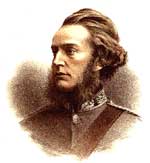|
Francis Charteris, 10th Earl of Wemyss
Francis Richard Charteris, 10th Earl of Wemyss GCVO DL (pronounced weems, rhyming with seems) (4 August 1818 – 30 June 1914), styled as Lord Elcho between 1853 and 1883, was a British Whig politician. He founded the Liberty and Property Defence League. Early lifeHe was the eldest son and heir of Francis Wemyss-Charteris, 9th Earl of Wemyss and Lady Louisa Bingham. Among his siblings was younger brother Richard Charteris (who married Lady Margaret Butler, a daughter of Richard Butler, 2nd Earl of Glengall) and sister Lady Louisa Wemyss-Charteris (wife of William Wells, MP for Beverley and Peterborough).[1] His paternal grandparents were Francis Douglas, 8th Earl of Wemyss and the former Margaret Campbell (daughter of Scottish landowner Walter Campbell, 3rd of Shawfield and Islay and 9th of Skipness). His maternal grandparents were Richard Bingham, 2nd Earl of Lucan and Lady Elizabeth Belasyse, third daughter of Henry Belasyse, 2nd Earl Fauconberg and former wife of Bernard Howard, 12th Duke of Norfolk.[1] He was educated at Eton and graduated from Christ Church, Oxford with a B.A. degree. CareerAs Lord Elcho he was commanding officer of the London Scottish Rifles Volunteers regiment for 17 years from its formation in 1859, gaining the rank of Lieutenant-Colonel. He is credited with the design of the Elcho sword bayonet, which saw limited use in the Ashanti campaign of 1895-6. Charteris was a member of the Canterbury Association from 27 March 1848, and belonged to the management committee.[2] He developed an interest in the alternative medical practice of Homeopathy, even becoming President of the London Homeopathic Hospital until his death. The strength of his belief is evidenced by his writing in March 1914:
Between 1836 and 1866, he was trustee of the National Portrait Gallery. Upon his father's death in 1883, he succeeded to the Earldom of Wemyss and March. Prior to then he was known as Lord Elcho. From 1881 to 1901, he was aide-de-camp to Queen Victoria, followed by aide-de-camp to King Edward VII from 1901 to 1910. He also held the office of Deputy Lieutenant of Haddington and Selkirk.
Personal life On 29 August 1843, he married Lady Anne Frederica Anson, the second daughter of Thomas Anson, 1st Earl of Lichfield and the former Louisa Barbara Catherine Phillips (youngest daughter of Nathaniel Phillips of Slebech Hall).[2] In Edinburgh, they lived at 64 Queen Street, the only four-bay townhouse on this prestigious street in Edinburgh's First New Town.[4] Together, they were the parents of six sons and three daughters, including:[1]
After the death of his first wife on 22 Jul 1896, he remarried, to Grace Blackburn (c. 1857–1946) in December 1900. Grace was the third daughter of Major John Blackburn and the former Maria Warburton (a daughter of The Very Reverend Charles Warburton, Archdeacon of Tuam).[1] Lord Wemyss died on 30 June 1914. The Dowager Countess of Wemyss died on 13 February 1946.[1] DescendantsThrough his daughter Lady Evelyn, he was a grandfather of Mary Gertrude Vesey, the second wife of Aubrey Herbert (second son of Henry Herbert, 4th Earl of Carnarvon), whose daughter Laura Herbert married the writer Evelyn Waugh, and was the mother of Auberon Waugh.[6] Honours and legacyCharteris Bay in Lyttelton Harbour was chosen as a locality name to commemorate his role in the settlement of Canterbury in New Zealand.[2] References
External linksWikimedia Commons has media related to Francis Charteris, 10th Earl of Wemyss. |
||||||||||||||||||||||||||||||||||||||||||||||||
Portal di Ensiklopedia Dunia


